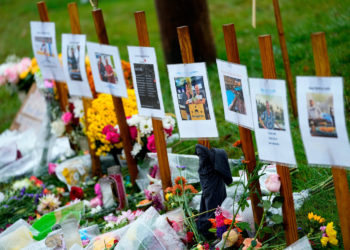Romeo Castellucci, 65, is one of today’s boldest and most sought-after opera directors. His hypnotic and rigorously detailed productions — he designs his own sets, costumes and lighting — often play out like riddles where beauty and brutality coexist. A leading practitioner of avant-garde theater since the 1980s, Castellucci has applied his radical artistry to opera over the past decade and a half. He began with a revelatory “Parsifal” in Brussels in 2011 that took a daringly abstract approach to Wagner’s mystical final opera.
Since then, he has worked at many of Europe’s major opera houses. He drew notice for a 2017 “Tannhäuser” in Munich with topless female archers and imagery of decomposing cadavers, as well as his 2018 Salzburg Festival debut: a production of “Salome” featuring a live black stallion and a shallow pool of milk onstage.
In late April, Castellucci will make his debut at the Teatro alla Scala in Milan with Debussy’s crepuscular opera “Pelléas et Mélisande,” based on the Symbolist play by Maurice Maeterlinck. The musical team includes the French conductor Maxime Pascal, a 20th-century music specialist, and the Swiss tenor Bernard Richter and the Catalan soprano Sara Blanch as Debussy’s tragic lovers.
Castellucci discussed his approach to creating his onstage enigmas. The interview has been edited and condensed.
What inspired you to start directing opera? Do you approach directing opera differently than you do theater?
I have a musical mentality. When I approach an image onstage, I’m always thinking with a sound or melody. For a long time, I’ve worked with the American electronic composer Scott Gibbons. That allowed me to jump into classical music in quite a natural way. For me, it’s all theater. I haven’t changed; I used to make theater with sound, electronic music, noise — a lot of noises — voices, and now I make it with an orchestra.
What attracts you to working in opera?
For me, opera is still a virgin forest, where I can discover a lot of things. Mahler once said that the opera house cannot be a temple of the ashes, but that we have to give it new fire. It has to burn.
In my opinion, we cannot be decorative in our day. For me, theater is also another way to make philosophy, not because I’m a philosopher, but because the theater is a place to think. That is the origin of Western theater. It’s that reason we go to the theater together: in order to receive a problem that we, as citizens, have to confront and solve. But only through a wound, only through a trauma. Tragedy was a trauma, in a way, and you have to find the solution.
I think that every experience in art has to be a kind of a wound. A wound is not a piece of cake.
Where do you start with a production?
First of all, I only say yes to pieces that speak to me and that I feel in my skin. I need mythology because mythology is universal. You can transform or sublimate it into something that touches the spectator. That’s the point. The music is a channel in order to enter the body of the spectator.
So you want the audience to participate?
I believe in the role of the spectator in a very active way. I leave a space for the spectator. He has to finish the work. Otherwise, it’s not an experience for him, but just an object in front of him. In order to achieve that, you have to study the libretto deeply.
How does it feel to be making your La Scala debut with “Pelléas et Mélisande?”
I think that for the Milanese, “Pelléas et Mélisande” is something of an unknown object, and that fact has allowed me to work without fear. The opera is so sophisticated from a psychological and philosophical point of view. The unsaid is more important that than what is said.
It’s not by chance that the opera opens with a man lost like a child in a forest, similar to the beginning of “The Divine Comedy.” You have to be lost in order to find something. And the price of being lost is giving up control. But that can allow you to discover another world. I think that it is worth working in theater for that reason, because it’s still a place where you can burn a fire.
The post A Creator of Enigmas Tackles Debussy’s Operatic Masterpiece appeared first on New York Times.




